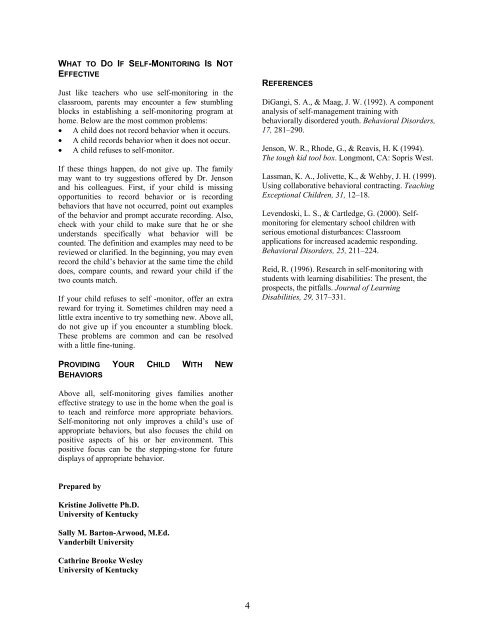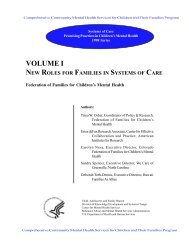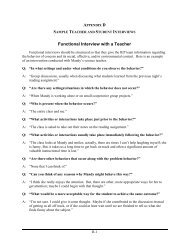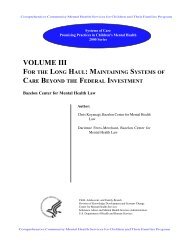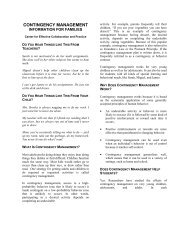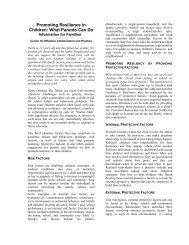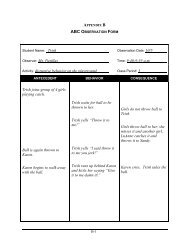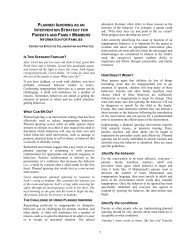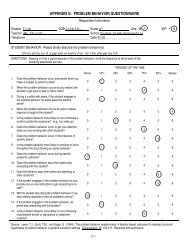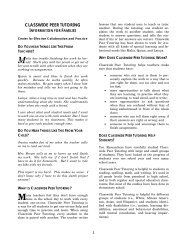Self-Monitoring at Home with Your Child - Center for Effective ...
Self-Monitoring at Home with Your Child - Center for Effective ...
Self-Monitoring at Home with Your Child - Center for Effective ...
Create successful ePaper yourself
Turn your PDF publications into a flip-book with our unique Google optimized e-Paper software.
WHAT TO DO IF SELF-MONITORING IS NOT<br />
EFFECTIVE<br />
Just like teachers who use self-monitoring in the<br />
classroom, parents may encounter a few stumbling<br />
blocks in establishing a self-monitoring program <strong>at</strong><br />
home. Below are the most common problems:<br />
• A child does not record behavior when it occurs.<br />
• A child records behavior when it does not occur.<br />
• A child refuses to self-monitor.<br />
If these things happen, do not give up. The family<br />
may want to try suggestions offered by Dr. Jenson<br />
and his colleagues. First, if your child is missing<br />
opportunities to record behavior or is recording<br />
behaviors th<strong>at</strong> have not occurred, point out examples<br />
of the behavior and prompt accur<strong>at</strong>e recording. Also,<br />
check <strong>with</strong> your child to make sure th<strong>at</strong> he or she<br />
understands specifically wh<strong>at</strong> behavior will be<br />
counted. The definition and examples may need to be<br />
reviewed or clarified. In the beginning, you may even<br />
record the child’s behavior <strong>at</strong> the same time the child<br />
does, compare counts, and reward your child if the<br />
two counts m<strong>at</strong>ch.<br />
If your child refuses to self -monitor, offer an extra<br />
reward <strong>for</strong> trying it. Sometimes children may need a<br />
little extra incentive to try something new. Above all,<br />
do not give up if you encounter a stumbling block.<br />
These problems are common and can be resolved<br />
<strong>with</strong> a little fine-tuning.<br />
PROVIDING YOUR CHILD WITH NEW<br />
BEHAVIORS<br />
Above all, self-monitoring gives families another<br />
effective str<strong>at</strong>egy to use in the home when the goal is<br />
to teach and rein<strong>for</strong>ce more appropri<strong>at</strong>e behaviors.<br />
<strong>Self</strong>-monitoring not only improves a child’s use of<br />
appropri<strong>at</strong>e behaviors, but also focuses the child on<br />
positive aspects of his or her environment. This<br />
positive focus can be the stepping-stone <strong>for</strong> future<br />
displays of appropri<strong>at</strong>e behavior.<br />
Prepared by<br />
Kristine Jolivette Ph.D.<br />
University of Kentucky<br />
Sally M. Barton-Arwood, M.Ed.<br />
Vanderbilt University<br />
C<strong>at</strong>hrine Brooke Wesley<br />
University of Kentucky<br />
4<br />
REFERENCES<br />
DiGangi, S. A., & Maag, J. W. (1992). A component<br />
analysis of self-management training <strong>with</strong><br />
behaviorally disordered youth. Behavioral Disorders,<br />
17, 281–290.<br />
Jenson, W. R., Rhode, G., & Reavis, H. K (1994).<br />
The tough kid tool box. Longmont, CA: Sopris West.<br />
Lassman, K. A., Jolivette, K., & Wehby, J. H. (1999).<br />
Using collabor<strong>at</strong>ive behavioral contracting. Teaching<br />
Exceptional <strong>Child</strong>ren, 31, 12–18.<br />
Levendoski, L. S., & Cartledge, G. (2000). <strong>Self</strong>monitoring<br />
<strong>for</strong> elementary school children <strong>with</strong><br />
serious emotional disturbances: Classroom<br />
applic<strong>at</strong>ions <strong>for</strong> increased academic responding.<br />
Behavioral Disorders, 25, 211–224.<br />
Reid, R. (1996). Research in self-monitoring <strong>with</strong><br />
students <strong>with</strong> learning disabilities: The present, the<br />
prospects, the pitfalls. Journal of Learning<br />
Disabilities, 29, 317–331.


